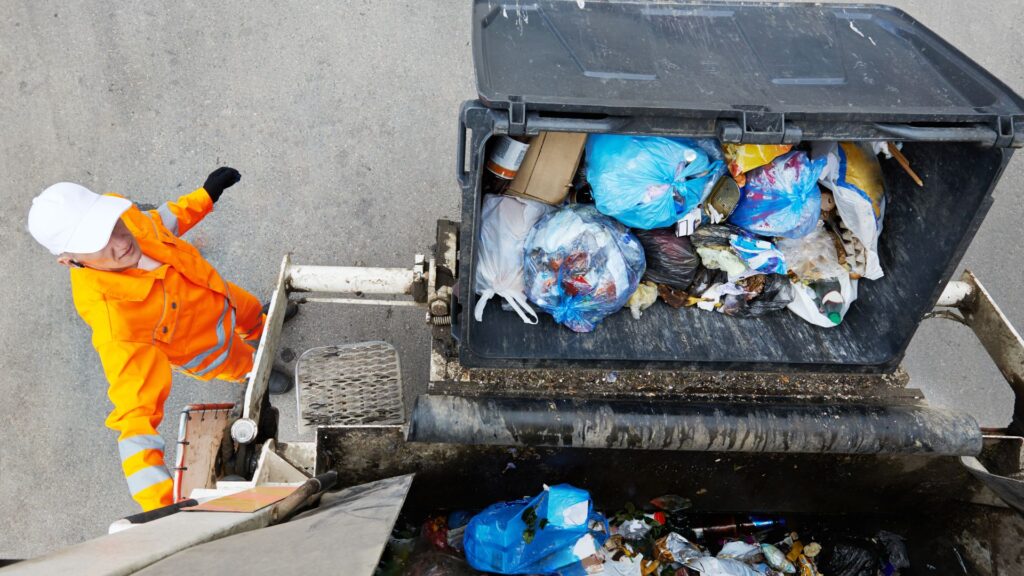
How to Reduce Your Junk’s Carbon Footprint with Eco-Friendly Disposal
September 23, 2025
The Impact of Recycling Scrap Metal on Global Sustainability
September 23, 2025How to Handle Toxic E-Waste in an Eco-Friendly Manner
The rise of digital technology has brought countless conveniences, but it has also created a growing environmental challenge: electronic waste. From old laptops and broken smartphones to outdated televisions, e-waste is one of the fastest-growing waste streams worldwide. These discarded items often contain hazardous materials such as lead, mercury, and cadmium, which can cause serious harm to both people and the planet if not managed properly. Handling toxic e-waste in an eco-friendly way is more than just a responsible choice—it is a necessity. Understanding the right methods ensures that electronics are recycled, repurposed, or safely disposed of.
Understanding the dangers of toxic e-waste
Electronic devices often contain hidden dangers that most people are unaware of. Beneath the sleek designs and colorful screens are toxic substances such as mercury, lead, and flame retardants. When e-waste is tossed into regular trash, these materials can leach into soil and contaminate groundwater, creating long-term environmental risks. Communities exposed to these pollutants may suffer from health complications that are difficult to trace but deeply damaging.
By understanding the toxic nature of e-waste, it becomes clear why eco-friendly handling is essential. Responsible disposal ensures that these harmful substances are extracted and treated properly. Recycling facilities use specialized processes to separate dangerous materials from reusable components, reducing the potential for contamination. Awareness is the first step toward change. Once individuals recognize the dangers lurking in their discarded gadgets, they are more likely to support safe recycling systems and avoid careless disposal practices that threaten public health and ecosystems.
Why proper disposal of electronics matters
When electronics are improperly discarded, their environmental footprint multiplies. Items left in landfills not only occupy space but also release harmful toxins over time. Old computers, for instance, can contain leaded glass in their monitors, while cell phones often carry arsenic and cadmium. These substances slowly seep into soil and waterways, creating pollution that is costly and often irreversible.
Proper disposal helps mitigate these risks while simultaneously recovering valuable materials. Metals like gold, silver, and copper are often embedded within electronic devices. Recycling extracts these elements, allowing them to be reused in new products instead of being wasted. This reduces reliance on mining, which is energy-intensive and destructive to ecosystems. Ultimately, proper disposal transforms a potential environmental hazard into an opportunity for sustainable resource management. Every responsibly recycled device contributes to cleaner air, safer water, and a healthier planet for future generations.

How recycling e-waste protects communities
Communities bear the heaviest burden of toxic e-waste when it is not handled responsibly. Improper dumping can contaminate local water supplies and degrade the quality of air residents breathe daily. This pollution often goes unnoticed until it manifests in rising health issues, such as respiratory illnesses or neurological problems linked to exposure to heavy metals. Vulnerable populations, especially children, are at the greatest risk.
Recycling e-waste changes this outcome by channeling electronics into controlled systems designed for safe processing. Certified recycling centers dismantle devices carefully, separating hazardous elements from recyclable parts. This reduces exposure risks and prevents toxic materials from entering the environment. Communities benefit not only through cleaner surroundings but also from economic opportunities, as recycling centers generate jobs and provide reusable materials for industries. Safe recycling, therefore, is not just an environmental act but a protective measure for the people living closest to these waste streams.
The role of government regulations in e-waste management
Government regulations are crucial in shaping how societies manage electronic waste. Without structured guidelines, disposal practices can vary widely, often leading to unsafe handling or illegal dumping. Regulations establish clear standards for manufacturers, consumers, and recyclers, ensuring accountability across the lifecycle of electronic products. These rules often require companies to take responsibility for the end-of-life management of their devices, encouraging more sustainable product designs.
Enforcement of regulations also safeguards the public from harmful exposure. For instance, strict penalties for improper disposal discourage businesses from cutting corners. At the same time, incentives for recycling programs motivate communities to participate actively. Government-led awareness campaigns can further educate citizens about safe practices. By setting a foundation of accountability and education, regulations create a system where toxic e-waste is less likely to harm people or ecosystems. Strong policies, backed by consistent enforcement, make sustainable waste management achievable at scale.
How businesses can reduce e-waste responsibly
Businesses are significant contributors to electronic waste due to frequent equipment upgrades and large-scale operations. However, they also hold immense potential to set sustainability standards. By adopting responsible e-waste reduction practices, companies can limit the harmful effects of their discarded devices. Strategies include donating older equipment to schools or nonprofits, extending the lifespan of devices through maintenance, or working with certified recycling services for proper disposal.
Beyond environmental benefits, responsible e-waste management can enhance a company’s reputation. Consumers increasingly value businesses that prioritize sustainability and eco-friendly operations. Companies that commit to ethical disposal not only reduce their environmental footprint but also demonstrate corporate responsibility. Moreover, they often save costs by recovering valuable materials through recycling. Businesses have the resources and influence to lead by example, making their role in e-waste reduction pivotal in the global pursuit of sustainability. Responsible practices at the corporate level ripple across industries and communities alike.
The importance of certified e-waste recycling centers
Not all recycling centers are equipped to handle electronic waste safely. Certified facilities undergo rigorous assessments to ensure they follow strict environmental and safety standards. These centers are trained to dismantle electronics without releasing toxic substances into the environment, a process that requires both specialized equipment and skilled workers. Choosing certified recyclers guarantees that devices are handled in a way that prioritizes both human health and ecological protection.
Certified centers also track the flow of materials, ensuring transparency in where components end up. Hazardous materials are disposed of responsibly, while valuable metals and plastics are directed back into manufacturing industries. This closed-loop system reduces the need for raw resource extraction and lessens environmental damage. For individuals and businesses alike, selecting certified recycling centers provides peace of mind.
How reusing and repurposing electronics makes a difference
While recycling is vital, reusing electronics can be even more impactful in reducing e-waste. Many devices are discarded while still functional, often due to the lure of newer technology. By donating or repurposing these electronics, their lifespan is extended, delaying the point at which they become waste. Schools, charities, and small businesses often benefit from refurbished computers, phones, and printers.
Repurposing also reduces the environmental costs associated with manufacturing new devices. Every reused item saves the resources and energy that would otherwise be consumed in production. Additionally, creative repurposing can give outdated gadgets a second life, such as converting old tablets into digital photo frames or using parts for DIY projects. By choosing to reuse before recycling, individuals contribute to a culture of sustainability.
How technology advances help manage toxic e-waste
Advancements in technology are reshaping how societies address electronic waste. Modern recycling methods now include robotic systems capable of sorting devices with incredible accuracy, as well as chemical processes designed to recover valuable materials more efficiently. These innovations reduce the risk of hazardous exposure while maximizing the recovery rate of reusable components.
Emerging technologies also support safer product design. Manufacturers are exploring eco-friendly materials and modular designs that make devices easier to repair and recycle. These shifts reduce the challenges associated with traditional e-waste management. By integrating advanced technologies into both production and disposal processes, the industry moves closer to a sustainable cycle. Technology not only generates the problem of e-waste but also provides the solutions needed to manage it effectively.
Educating individuals about eco-friendly e-waste practices
Awareness is a powerful tool in combating the dangers of toxic e-waste. Many individuals simply do not know the risks associated with throwing electronics in the trash or are unaware of recycling options available in their communities. Educating the public ensures that people understand both the hazards and the solutions. Outreach programs, community workshops, and informational campaigns can bridge this gap effectively.
Once informed, individuals are more likely to make responsible choices, such as taking devices to certified recyclers or repurposing old gadgets instead of discarding them. Education also fosters a culture of accountability, where households see themselves as active participants in sustainability rather than passive consumers. The impact of informed decisions is far-reaching. By empowering individuals with knowledge, communities create collective change.
Building a sustainable future through e-waste management
Tackling the e-waste crisis requires a shared vision for sustainability. Governments, businesses, and individuals must work together to ensure that electronic devices are handled responsibly throughout their lifecycle. A sustainable future relies on systems that prioritize safe disposal, recycling, and reuse, as well as innovation that reduces the environmental footprint of new devices.
This collective responsibility creates resilience in the face of growing technological demand. By adopting sustainable practices today, society ensures that future generations inherit a healthier planet, free from the lingering dangers of toxic e-waste. Building such a future requires commitment at every level, from global policies to local recycling initiatives. The good news is that each contribution, whether from a household or an industry leader, makes a measurable difference
Conclusion
North Bay Junk Removal stands as a trusted partner for responsible e-waste and junk removal services in Santa Rosa, CA. With a focus on eco-friendly practices, they ensure that hazardous electronics and other waste are managed through recycling, repurposing, and safe disposal methods. Their approach prevents harmful toxins from entering landfills and protects both local communities and the environment. By prioritizing sustainability, they help conserve valuable resources while reducing pollution and emissions.
For residents and businesses seeking dependable junk removal solutions, North Bay Junk Removal provides both efficiency and environmental responsibility. They combine local care with global sustainability goals, making it easy for clients to clear out unwanted items while contributing positively to the planet. To learn more or to schedule a service, call 707-478-6817 today. Choosing North Bay Junk Removal means embracing cleaner practices and taking a step toward a greener future with every removal project.




